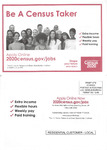 |
| Angelika/Mike Schilli |
|
|
|
Angelika It's hard to believe that yet another ten years have gone by, and it's time again for the US Census again. This one is our third time around (2000, 2010, 2020), but like everything today it was heavily influenced by Corona. Ten years ago, there was a questionaired mailed to individual households (Rundbrief 05/2010), which had to be completed. For those who did not comply, a friendly census employee came by in person, to knock on the door and help filling out the form. This time around, it was pretty evident, even before Corona hit, that the bureau had hoped to get people to answer the census questions online. It was the first time in history that this option even existed. And because of Corona, the bureau naturally aimed to reduce the number of census employees having to visit people in their homes.
The change from a paper-based survey to an online version naturally raised privacy concerns as well, because some of the data collected is quite sensitive. Experts feared security leaks and hacker attacks, so precautions had to be taken. What's the census for? The goal is to account for every resident, regardless of citizenship or even legal status.
Shortly before the census started, some agitation arose because Trump and Company demanded to include one question about each surveyed resident's citizenship status. This in turn raised some concerns about skewed data, because non-citizens might have feared potential repercussions and might have been less willing to fill out and submit the questionaire. In states like California or New York with a large number of illegal immigrants, it's traditionally been a challenge to get everyone to participate in the census. But it's important to collect the data accurately, because it determines how much federal money each state receives for initiatives, or how many representatives it can send to congress. After some back and forth, the question was dropped, while the census bureau kept pushing for finalizing the forms, updating the online software, and starting the survey. Historically, the surveys between the years 1890 and 1950 did include the citizenship question, by the way.
Now, how was the survey actually conducted this year? One day, we found a letter from the census bureau in our mailbox. It wasn't addressed to an individual or a family. It just specified our address, which makes sense once you know that in the U.S. there is no central register the government could use to find out who lives where. The letter simply stated "to resident at" with our address.
The cover letter explained the reasons behind the census, and pointed out that recipients are legally required to participate. If for any reason the online option didn't seem to work out, a paper version would be delivered within a few weeks. The letter then pointed to the website "my2020census.gov" in a large font within a giant frame. It also listed a personalized identification number to be entered on the website to start the survey. I had to answer the following questions for our household:
1. How many people were living or staying in this house, apartment, or mobile home on April 1, 2020?
2. Were there any additional people staying here on April 1, 2020, that you did not include in Question 1? (This refers to people living there temporarily).
3. Is this house, apartment, or mobile home owned by you or someone in this household with a mortgage or loan (including home equity loans)? Is it owned by you or someone in this household free and clear (without a mortgage or loan)? Rented? Occupied without payment of rent?
4. What is your telephone number?
5. What is Person 1's name?
6. What is Person 1's sex?
7. What is Person 1's age and what is Person 1's date of birth?
8. Is Person 1 of Hispanic, Latino, or Spanish origin?
9. What is Person 1's race? Options are: White; Black or African American; American Indian or Alaska Native; Chinese; Filipino; Asian Indian; Vietnamese; Korean; Japanese; other Asian; Native Hawaiian; Samoan; Chamorro; other Pacific Islander; some other race. Mark one or more boxes.
10. Print name of Person 2.
11. Does this person usually live or stay somewhere else?
12. How is this person related to Person 1?
13. What is Person 2's sex?
14. What is Person 2's age and what is Person 1's date of birth?
15. Is Person 2 of Hispanic, Latino, or Spanish origin?
16. What is Person 2's race?
And so on, depending how many people are living in the household. The question about a person's race is quite common in the U.S., although it might sound strange for German ears. If you were wondering about the differentiation between Spanish, Hispanic, and Latino above, the census form explains that for the purpose of the survey they determine a person's origin from Cuba, Mexica, Puerto Rica, South or Central America, or other Spanish culture, regardless of race.
It's also interesting that the survey asked for a person's full name. This is supposed to prevent duplicate counts. If someone didn't submit the form in a timely manner, the census bureau was quick to send out reminders. Recently, we had just returned home from a walk through the neighborhood, we saw a survey person at the door to our building, asking about parties in our building who hadn't filled out the questionaire yet. We of course had submitted ours online already.












